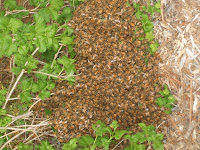









 Today is Monday, March 28th, 2011 and we've had two swarms in the past two weeks. The first occurred around March 15th while I was in Ocracoke for a seminar. The weather had been very warm and nice and one afternoon, Craig walked outside and heard a loud buzzing sound which alarmed him - a swarm??? He looked everywhere and did not find it. The neighbor confirmed that she had also heard bees buzzing. The following week, we confirmed that one of our hives had swarmed. Our agricultural extension agent (bee expert) examined all three hives and showed us an empty queen cell.
Today is Monday, March 28th, 2011 and we've had two swarms in the past two weeks. The first occurred around March 15th while I was in Ocracoke for a seminar. The weather had been very warm and nice and one afternoon, Craig walked outside and heard a loud buzzing sound which alarmed him - a swarm??? He looked everywhere and did not find it. The neighbor confirmed that she had also heard bees buzzing. The following week, we confirmed that one of our hives had swarmed. Our agricultural extension agent (bee expert) examined all three hives and showed us an empty queen cell.  See picture.
See picture.Once the new, young queen emerges from the queen cell, she will work on taking over the hive so the older queen makes the exit and takes most of her workers with her. (The new queen may be younger but who do you think is smarter or am I confusing this with a friend of mine who's husband just ran off with a younger woman) This process where the workers grow a new queen is called supersedure. We lost those bees and when it happened, I felt like a bad parent, neglecting my children.
But, today when the hive swarmed, Craig was like a dog on point, spotting them right away. Thank goodness he came home early to find them huddled in a tight ball in the oak leaf hydrangea bush freezing their little stingers off. Right away, he contacted the Wake County Beekeepers call list of people that help with swarms. I think we could have handled it but it was very nice to have Frank Borge come over and offer his assistance. By the way, if you are ever in the presence of a swarm, and have no intentions of keeping them, please protect them as much as possible by getting online and contacting by phone someone who will come and remove the bees for you. http://www.wakecountybeekeepers.org/swarm-list/
Anyway, they were cold, filled with honey and cooperative so we were able to place them into an empty hive. Craig had an empty 8 frame body filled with frames and an additional empty hive box. He put the frame filled body on the bottom board, set it up near the swarm and then put the empty box on top. We did it this way to avoid the problem of getting the bees inside the hive body while frames may have been in the way. Some instructions say to remove half the frames and then shake the bees into the space between the frames. But, then you are challenged with placing the frames back in the hive later when the bees may be in the way. What would be terrible would be to crush the queen when you are trying to return the frames to the box.
After putting the majority of the bees back in the new box, the rest found their way within about an hour. It was getting cooler and the sun was setting so we were happy to see that all had found their way back to their queen. She may be old, but she's still their queen. Let's hope they make it through this night when Greg Fishel predicts the temps will hover around 31 degrees. Stay warm little bees.


